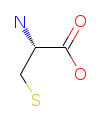Cysteine
Cysteine is known as a sulphur-containing non-essential amino acid. Being a key constituent of glutathione, this amino acid supports a lot of vital physiological functions. For example, glutathione, made from Cysteine, Glutamic acid, and Glycine, can be found in all tissues of the human body. In the meantime, the antioxidant activity of this component is attributed particularly to the presence of Cysteine in the compound.
Chemical structure of Cysteine

Identifiers and properties of Cysteine
IUPAC Name: (2R)-2-amino-3-sulfanylpropanoic acid
Symbol: Three-letter code - Cys. One-letter code - C
Molecular Weight (Molar Mass): 121.15818 g/mol
Molecular Formula (Structural Formula): C3H7NO2S
Canonical SMILES: C(C(C(=O)O)N)S
Isomeric SMILES: C([C@@H](C(=O)O)N)S
InChIKey Identifier: XUJNEKJLAYXESH-SNQCPAJUDK
CAS Number: 52-90-4
MDL Number: MFCD00064306
Melting point: 220 °C
RNA codons: UGU, UGC
Solubility in water: 280 g/L (25 °C); pKa - 1,96; pKb - 10,28
Rf value in n-butanol/acetic acid/water = 12:3:5 - 0.40
2D Molfile: Get the molfile
3D PDB file: Get the PDB file
Other names: (R)-2-Amino-3-mercaptopropionic acid; beta-Mercaptoalanine; Thioserine; CySH; 3-Mercapto-L-alanine
Benefits of L-Cysteine
This amino acid provides resistance to the body against all harmful effects, because it is responsible for building up white blood-cell activity. Cysteine is also necessary for the proper functioning of the skin and helps your body recover from surgery.
Cysteine is also used to produce Glutathione and Taurine. Since Cysteine is a non-essential amino acid, it can be produced by humans to satisfy their bodies' demands. If, for some reasons, your body is unable to produce this amino acid, you can find it in lots of high-protein foods like pork, chicken, eggs, milk, and cottage cheese. Vegetarians are recommended to pay more attention to eating garlic, granola and onions.
This amino acid is proved to be beneficial in numerous ways. First of all, it is essential for the detoxification and for the formation of skin. Besides, it participates in the recovery of hair and nail tissue. Then, Cysteine is used in manufacturing antioxidants and in protecting your brain and liver from damage made by alcohol and drugs consumption and even by a cigarette smoke. Finally, this amino acid helps protect against harmful toxins and damages caused by radiation.
According to various researches, other benefits of Cysteine include reducing the effects of aging on the human body. Besides, this amino acid also helps promote building muscles, healing of severe burns, and fat burning. Cysteine also encourages the activity of white blood cells. The list of benefits is virtually endless, including those like the effectiveness in treating bronchitis, angina and acute respiratory distress, and the ability to help maintain optimal health and improve immune system functioning.
Side Effects
People with diabetic tendencies should not use large supplemental doses of cysteine unless under supervision, as it is capable of inactivating insulin by reducing certain disulphide bonds which determine its structure. Pearson and Shaw note that in order to avoid the conversion of cysteine to cystine, with possible consequences as far as the formation of kidney or bladder stones, at least three times the dose of vitamin C should accompany the taking of cysteine supplementally.
Food Sources
Meat and Poultry. Chicken, turkey, beef, and pork are good sources of cysteine. These meats also provide other essential nutrients like iron and zinc.
Fish. Fish, such as tuna and salmon, contains cysteine. Fatty fish like salmon are also rich in omega-3 fatty acids.
Dairy Products. Milk, cheese, and yogurt are sources of cysteine. Dairy products are also good sources of calcium and other nutrients.
Eggs. Eggs, especially the whites, are rich in cysteine. Eggs are a complete protein source, providing all essential amino acids.
Legumes. Lentils, chickpeas, and soybeans contain cysteine. Legumes are also excellent sources of plant-based protein, fiber, and other nutrients.
Nuts and Seeds. Almonds, sunflower seeds, and chia seeds are examples of nuts and seeds that contain cysteine. These foods also provide healthy fats.
Garlic and Onions. Garlic and onions are rich in cysteine. They also contain other sulfur-containing compounds that contribute to their health benefits.
Incorporating a variety of these foods into your diet ensures that you obtain a well-rounded supply of cysteine along with other essential nutrients. If dietary restrictions or health conditions require a specific focus on cysteine intake, it's advisable to consult with a healthcare professional or a registered dietitian for personalized guidance.